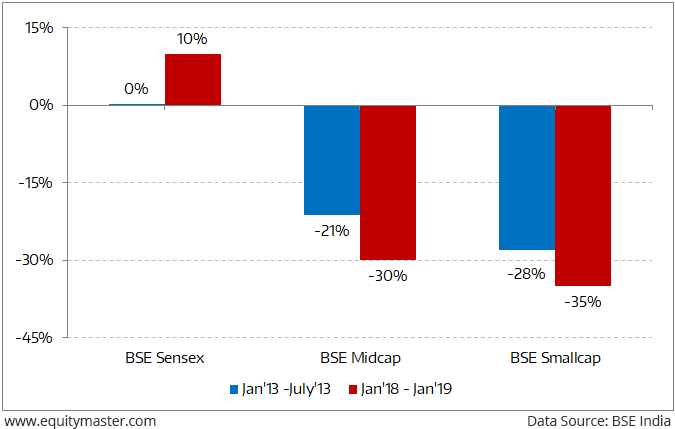Sensex Ends 54 Points Lower; Metal And IT Stocks Witness Selling
Share markets in India continued to trade in the red during closing hours and ended their trading session marginally lower. Sectoral indices ended on a mixed note with stocks in the IT sector and metal sector witnessing most of the selling pressure.
At the closing bell, the BSE Sensex stood lower by 54 points (down 0.2%) and the NSE Nifty closed down by 23 points (down 0.2%). The BSE Mid Cap index and the BSE Small Cap index ended the day down by 0.1%.
The rupee was trading at 69.92 against the US$.
Asian stock markets finished on a negative note. As of the most recent closing prices, the Hang Seng was down by 1.9% and the Shanghai Composite was down by 4.4%. The Nikkei 225 was down 2%.
Speaking of Indian share markets in general, the current scenario in the Indian stock market looks very similar to what happened in 2013.
Back then, mid and small cap stocks witnessed a similar correction while the BSE Sensex stayed put.
2018-19 has also followed a similar pattern.
Is It 2013 All Over Again?

Long term capital gains tax was introduced in last year's budget. We've seen corporate governance issues leading to auditor exits and finally the IL&FS impact.
The rally that followed in 2013 was led by mid and small caps.
Will 2019 pan out the same way?
As per research analyst, Sarvajeet Bodas, all you can do is control what can be controlled.
Pick up fundamentally strong stocks with able management at the helm.
These are businesses that have delivered earnings even in tough times.
These stocks are most likely to lead the next leg of the market rally when it happens.
Moving on to other news, as per a leading financial daily, equity inflows, including equity-linked savings scheme (ELSS) fell 16.8% to Rs 51.2 billion in February 2019 against Rs 61.5 billion reported in January 2019.
ELSS flow into equity (without arbitrage) declined 5.6% to Rs 11.7 billion on a month-on-month (MoM) basis.
Exchange Traded Fund flows however increased sharply to Rs 52.3 billion in month gone by, against Rs 7.2 billion in January 2019.
Balanced funds outflow stood at Rs 10.7 billion during the month against outflow of Rs 9.5 billion in previous month, and arbitrage fund outflow was at Rs 4.8 billion against outflow of Rs 10.7 billion MoM.
Total asset under management (AUM) at the end of February 2019 was at Rs 23.2 lakh crore, down marginally compared to Rs 23.4 lakh crore in January.
Speaking of equity inflows, overseas flows into domestic equities in February were the highest in 12 months. Foreign portfolio investors (FPIs) bought stocks worth US$1.9 billion, the highest since March 2018 when they had pumped in over US$2 billion.
FPIs have been taken out money in seven out of 12 months.
The reversal in overseas flows seen last month will boost investor sentiment, which has been hit due to escalation in cross-border tensions between India and Pakistan.
However, this flow tally needs to be taken with a pinch of salt.
The market has seen single-day FPI investment of US$1.7 billion, the highest in 4 years. This was on account of share sale by Dutch bank ING Group in Kotak Mahindra Bank.
As per the reports, high inflow tallies this month isn't necessarily due to change in sentiment. FPIs continue to remain cautious ahead of elections.
Indian equities have had a tough time in the past one year. With elections around the corner, volatility in the markets has been on a constant rise.
Till date in FY18-19, foreign investors have pulled out around Rs 515 billion from the Indian equity market.
But there's also an interesting development seen this time...
In the past, such panic would have meant the domestic investor would have followed suit.
That hasn't happened this time.
Domestic investors have shown surprising resiliency to the market's volatility.
The month-wise SIP in FY18-19 has seen a constant rise.
Also, close to 1 million new SIP accounts have been added during FY18-19 according to AMFI.
The days of knee-jerk panic withdrawals by individual investors are slowly but surely reducing. If they ride out this volatility they will see the benefit of the cycle turning in their favor.
That will mark a significant change in the mindset of the retail investor for the long term.
From the banking space, Lakshmi Vilas Bank share price was in focus today. Stock of the lender witnessed selling pressure after its qualified institutional placement (QIP) issue opened for subscription yesterday.
The QIP is a part of the lender's plan of raising about Rs 20 billion through various modes, primarily through a preferential allotment of shares and QIPs.
In the news from the commodity space, crude oil was witnessing selling pressure today.
Losses were seen on the back of volatility seen in the global economy after the European Central Bank (ECB) warned overnight of continued weakness and as fresh data showed Chinese exports and imports slumped last month.
Note that The ECB changed track on its tightening plan on Thursday, offering banks a new round of cheap loans to help revive the eurozone economy.
The bolder-than-expected move came as the US Federal Reserve and other central banks around the world are also holding back on rate hikes.
It underlined how a global trade war, Brexit uncertainty and simmering debt concerns in Italy are taking their toll on economic growth across Europe.
The policy changes cast ECB President Mario Draghi once again as nurturer of confidence in the bloc's still-fragile economy, only months after the bank announced the end of four years of unprecedented asset purchases, and as Draghi himself prepares to hand over the reins to a successor later this year.
The ECB now sees eurozone growth at barely 1.1% this year, compared to the 1.7% it projected in December.



